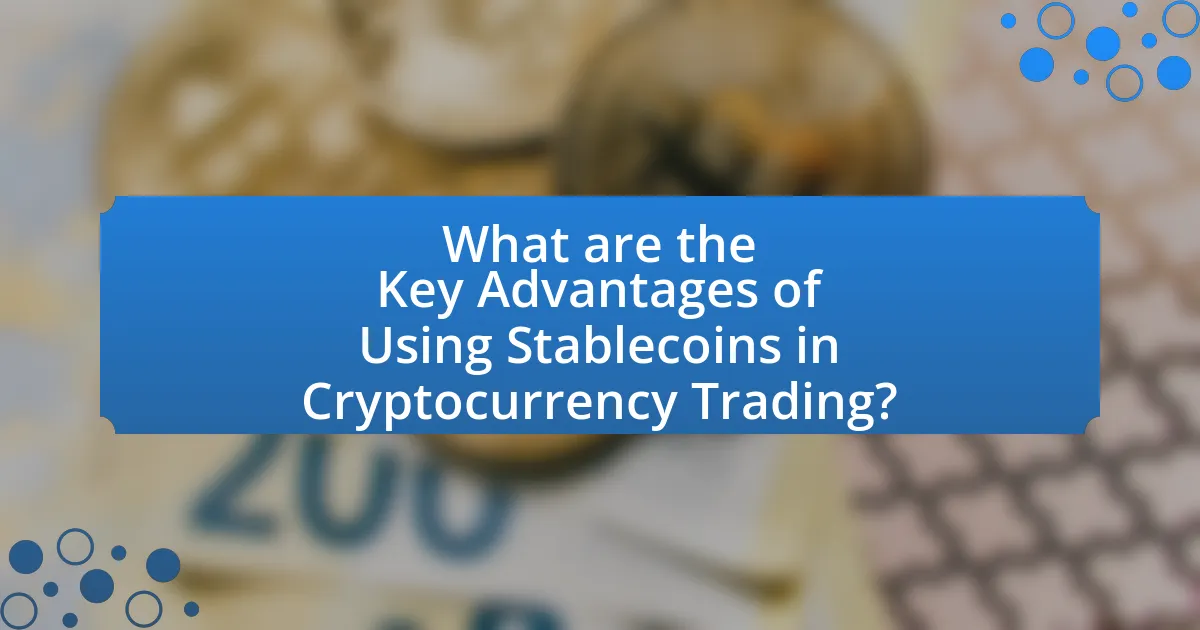Stablecoins are a type of cryptocurrency designed to maintain a stable value by pegging their worth to reserve assets, such as fiat currencies or commodities. This article explores the advantages of using stablecoins in cryptocurrency trading, highlighting their role in providing price stability, reducing volatility, and enhancing liquidity. Key mechanisms that ensure the stability of stablecoins, such as collateralization and algorithmic stabilization, are discussed, along with their importance in risk management and trading efficiency. Additionally, the article addresses potential challenges and considerations for traders, including regulatory risks and security concerns, while examining future prospects and emerging trends in the stablecoin market.

What are Stablecoins and How Do They Function in Cryptocurrency Trading?
Stablecoins are a type of cryptocurrency designed to maintain a stable value by pegging their worth to a reserve of assets, such as fiat currencies or commodities. They function in cryptocurrency trading by providing a reliable medium of exchange and a store of value, which helps traders mitigate the volatility commonly associated with other cryptocurrencies. For instance, Tether (USDT) is pegged to the US dollar, allowing users to transact without the risk of significant price fluctuations. This stability enables traders to easily enter and exit positions, facilitating liquidity in the market and making stablecoins an essential tool for risk management in cryptocurrency trading.
What distinguishes stablecoins from other cryptocurrencies?
Stablecoins are distinguished from other cryptocurrencies primarily by their price stability, which is typically achieved through pegging to a reserve asset, such as fiat currency or commodities. Unlike volatile cryptocurrencies like Bitcoin or Ethereum, which can experience significant price fluctuations, stablecoins maintain a stable value, making them more suitable for transactions and trading. For example, Tether (USDT) is pegged to the US dollar, ensuring that one USDT is always worth approximately one dollar. This stability allows users to avoid the risks associated with price volatility, facilitating easier adoption for everyday transactions and providing a reliable medium of exchange in the cryptocurrency market.
How are stablecoins pegged to traditional currencies?
Stablecoins are pegged to traditional currencies through mechanisms that maintain a fixed exchange rate, typically by backing the stablecoin with reserves of the underlying currency or assets. For example, a stablecoin like Tether (USDT) is designed to maintain a 1:1 value with the US dollar by holding an equivalent amount of USD in reserve, ensuring that each stablecoin can be redeemed for one dollar. This backing provides stability and reduces volatility, which is crucial for users who want to trade cryptocurrencies without the risk of significant price fluctuations.
What mechanisms ensure the stability of stablecoins?
Stablecoins maintain their stability through mechanisms such as collateralization, algorithmic stabilization, and reserve management. Collateralized stablecoins are backed by assets like fiat currency or commodities, ensuring that each stablecoin issued is redeemable for a specific amount of the underlying asset, which helps maintain its value. For example, Tether (USDT) claims to be backed 1:1 by US dollars held in reserve, providing a direct link to the value of the dollar.
Algorithmic stablecoins, on the other hand, use smart contracts to control supply and demand dynamically. They automatically adjust the supply of the stablecoin based on market conditions, which helps stabilize its price. An example is TerraUSD (UST), which adjusts its supply based on the demand for its associated cryptocurrency, LUNA.
Additionally, effective reserve management practices, such as regular audits and transparency about reserves, further enhance trust and stability in stablecoins. For instance, Circle, the issuer of USD Coin (USDC), undergoes monthly audits to verify that its reserves match the number of USDC in circulation, reinforcing confidence in its stability.
Why are stablecoins important in the cryptocurrency market?
Stablecoins are important in the cryptocurrency market because they provide price stability, which facilitates trading and investment. Unlike traditional cryptocurrencies that can experience significant volatility, stablecoins are pegged to stable assets like fiat currencies, allowing users to transact without the fear of drastic price fluctuations. For instance, Tether (USDT) and USD Coin (USDC) maintain a 1:1 value with the US dollar, making them reliable for traders seeking to hedge against market volatility. This stability encourages broader adoption and use in various applications, including remittances and decentralized finance (DeFi), where predictable pricing is crucial for effective financial planning and risk management.
How do stablecoins mitigate volatility in trading?
Stablecoins mitigate volatility in trading by maintaining a stable value pegged to a reserve of assets, typically fiat currencies like the US dollar. This pegging mechanism allows stablecoins to provide a reliable medium of exchange, reducing the price fluctuations commonly associated with cryptocurrencies. For example, Tether (USDT) and USD Coin (USDC) are designed to maintain a 1:1 value with the US dollar, which helps traders avoid the extreme volatility seen in assets like Bitcoin or Ethereum. By offering a stable alternative, stablecoins facilitate smoother transactions and provide a safe haven during market downturns, thereby enhancing overall trading efficiency.
What role do stablecoins play in liquidity provision?
Stablecoins play a crucial role in liquidity provision by offering a stable medium of exchange that mitigates the volatility typically associated with cryptocurrencies. Their pegged value to fiat currencies allows traders to quickly enter and exit positions without the risk of significant price fluctuations, thereby enhancing market efficiency. For instance, during periods of high volatility, stablecoins can facilitate smoother transactions and provide a reliable store of value, which is essential for maintaining liquidity in trading platforms. This stability encourages more participants to engage in trading activities, ultimately increasing overall market liquidity.

What are the Key Advantages of Using Stablecoins in Cryptocurrency Trading?
The key advantages of using stablecoins in cryptocurrency trading include price stability, reduced volatility, and enhanced liquidity. Price stability allows traders to avoid the drastic fluctuations commonly associated with traditional cryptocurrencies, making it easier to manage risk. For instance, stablecoins like Tether and USD Coin are pegged to fiat currencies, which helps maintain their value. Reduced volatility enables traders to execute transactions without the fear of sudden price drops, facilitating smoother trading experiences. Enhanced liquidity is another significant advantage, as stablecoins can be easily converted into other cryptocurrencies or fiat currencies, allowing for quick entry and exit from positions. This liquidity is crucial in fast-paced trading environments, where timing can significantly impact profitability.
How do stablecoins enhance trading efficiency?
Stablecoins enhance trading efficiency by providing price stability, which reduces volatility in cryptocurrency markets. This stability allows traders to execute transactions without the fear of sudden price fluctuations, facilitating quicker decision-making and execution. For instance, during periods of high market volatility, stablecoins maintain a consistent value, often pegged to fiat currencies like the US dollar, enabling traders to hedge against market risks effectively. Additionally, stablecoins streamline the trading process by allowing for faster transactions and lower fees compared to traditional banking systems, as they can be transferred instantly on blockchain networks. This combination of stability and efficiency makes stablecoins a preferred choice for traders looking to optimize their trading strategies.
What impact do stablecoins have on transaction speed?
Stablecoins significantly enhance transaction speed in cryptocurrency trading. By utilizing blockchain technology, stablecoins facilitate near-instantaneous transactions compared to traditional banking systems, which can take several days to process. For instance, transactions involving stablecoins like USDC or Tether can be completed in seconds, allowing traders to execute trades quickly and efficiently. This rapid transaction capability is particularly beneficial during volatile market conditions, where timing is crucial for maximizing profits.
How do stablecoins reduce transaction costs?
Stablecoins reduce transaction costs by providing a stable value that minimizes volatility, which in turn lowers the fees associated with currency conversion and price fluctuations. Traditional cryptocurrencies often experience significant price swings, leading to higher transaction costs due to the need for frequent conversions to stable fiat currencies. For example, a study by the Cambridge Centre for Alternative Finance found that stablecoins can facilitate faster and cheaper cross-border transactions compared to traditional banking systems, which often charge high fees and take longer to process. By maintaining a peg to stable assets like the US dollar, stablecoins enable users to transact with lower fees and greater predictability, making them a cost-effective option in cryptocurrency trading.
What are the risk management benefits of using stablecoins?
Stablecoins provide significant risk management benefits in cryptocurrency trading by offering price stability, which mitigates volatility risks associated with traditional cryptocurrencies. Their pegged value to stable assets, such as fiat currencies, allows traders to avoid drastic price fluctuations, enabling more predictable trading strategies. For instance, during market downturns, traders can convert volatile assets into stablecoins to preserve capital, reducing exposure to losses. Additionally, stablecoins facilitate easier liquidity management, as they can be quickly converted back into fiat or other cryptocurrencies without significant slippage. This liquidity advantage is crucial for executing trades efficiently and minimizing risk during market volatility.
How do stablecoins protect against market fluctuations?
Stablecoins protect against market fluctuations by maintaining a stable value, typically pegged to a fiat currency like the US dollar. This pegging mechanism ensures that the value of stablecoins remains relatively constant, reducing volatility compared to traditional cryptocurrencies. For instance, Tether (USDT) and USD Coin (USDC) are designed to be worth one dollar, which provides users with a reliable medium of exchange and store of value during turbulent market conditions. The stability is often achieved through collateralization, where each stablecoin is backed by reserves of the pegged asset, ensuring that users can redeem their stablecoins for the equivalent amount of the underlying asset. This structure allows stablecoins to serve as a safe haven for traders and investors, enabling them to hedge against the price swings commonly associated with cryptocurrencies.
What strategies can traders employ using stablecoins for risk management?
Traders can employ several strategies using stablecoins for risk management, including hedging against volatility, liquidity provision, and portfolio diversification. Hedging against volatility involves converting a portion of their cryptocurrency holdings into stablecoins during market downturns to preserve capital, as stablecoins maintain a stable value relative to fiat currencies. For instance, during the 2020 cryptocurrency market crash, many traders shifted to stablecoins like USDT or USDC to mitigate losses.
Liquidity provision allows traders to quickly enter and exit positions without significant price slippage, as stablecoins facilitate faster transactions on exchanges. This is particularly beneficial in volatile markets where price fluctuations can occur rapidly. Additionally, portfolio diversification can be achieved by allocating a portion of assets into stablecoins, which can reduce overall portfolio risk while still allowing for exposure to potential gains in other cryptocurrencies.
These strategies demonstrate how stablecoins can effectively manage risk in cryptocurrency trading by providing stability, liquidity, and diversification.

What Challenges and Considerations Should Traders Be Aware of When Using Stablecoins?
Traders should be aware of several challenges and considerations when using stablecoins, including regulatory risks, counterparty risks, and liquidity issues. Regulatory risks arise as governments worldwide are increasingly scrutinizing stablecoins, which could lead to sudden changes in legal status or operational requirements. Counterparty risks exist because the stability of a stablecoin often depends on the issuer’s ability to maintain reserves, and any failure in this regard can lead to a loss of value. Additionally, liquidity issues may arise during market volatility, where stablecoins may not be easily convertible to fiat or other cryptocurrencies, potentially leading to slippage or unfavorable trading conditions. These factors highlight the importance of thorough due diligence and risk management when trading with stablecoins.
What are the potential risks associated with stablecoins?
The potential risks associated with stablecoins include regulatory uncertainty, counterparty risk, and market volatility. Regulatory uncertainty arises as governments and financial authorities are still developing frameworks to govern stablecoins, which can lead to sudden changes in legality or compliance requirements. Counterparty risk is present because many stablecoins are backed by reserves held by third parties, and if these entities fail or mismanage funds, the value of the stablecoin can be compromised. Market volatility can also affect stablecoins, particularly if they are not fully backed by stable assets, leading to price fluctuations that undermine their intended purpose of stability. For instance, the collapse of TerraUSD in May 2022 highlighted how algorithmic stablecoins can fail, resulting in significant losses for investors.
How can regulatory changes impact stablecoin usage?
Regulatory changes can significantly impact stablecoin usage by altering the legal framework within which these digital assets operate. For instance, stricter regulations may require stablecoin issuers to comply with enhanced transparency and reserve requirements, potentially reducing the number of stablecoins available in the market. A notable example is the European Union’s Markets in Crypto-Assets (MiCA) regulation, which aims to create a comprehensive regulatory framework for cryptocurrencies, including stablecoins. This regulation could lead to increased compliance costs for issuers, thereby affecting their operational viability and market presence. Conversely, favorable regulatory developments, such as clear guidelines for stablecoin usage, can enhance consumer confidence and encourage broader adoption, as seen in jurisdictions that have embraced digital currencies with supportive legislation.
What are the security concerns related to stablecoins?
Security concerns related to stablecoins include the risk of counterparty default, regulatory scrutiny, and potential vulnerabilities in smart contracts. Counterparty default occurs when the issuer of the stablecoin fails to maintain the necessary reserves, which can lead to a loss of value for users. Regulatory scrutiny has increased as governments seek to ensure compliance with financial regulations, which can impact the stability and usability of stablecoins. Additionally, vulnerabilities in smart contracts can expose stablecoins to hacking and fraud, as evidenced by incidents where decentralized finance platforms have been exploited, resulting in significant financial losses.
How can traders effectively integrate stablecoins into their trading strategies?
Traders can effectively integrate stablecoins into their trading strategies by using them for liquidity management and risk mitigation. By holding stablecoins, traders can quickly convert volatile assets into a stable medium, allowing them to maintain purchasing power during market fluctuations. For instance, during a market downturn, a trader can sell a portion of their cryptocurrency holdings for stablecoins, thus avoiding losses while waiting for a more favorable market condition to reinvest. Additionally, stablecoins facilitate faster transactions and lower fees compared to traditional banking systems, enhancing overall trading efficiency. According to a report by CoinMetrics, stablecoins accounted for over 60% of the total trading volume in the cryptocurrency market in 2021, highlighting their growing importance in trading strategies.
What best practices should traders follow when using stablecoins?
Traders should prioritize security, liquidity, and regulatory compliance when using stablecoins. Ensuring the security of stablecoin holdings involves using reputable wallets and exchanges, as well as enabling two-factor authentication to protect against hacks. Maintaining liquidity is crucial; traders should choose stablecoins that are widely accepted and have high trading volumes to facilitate easy conversions. Additionally, staying informed about regulatory developments is essential, as compliance with local laws can impact the usability and legality of certain stablecoins. For instance, the U.S. Treasury has issued guidelines on stablecoin regulation, emphasizing the importance of adhering to financial regulations to avoid legal issues.
How can traders leverage stablecoins for arbitrage opportunities?
Traders can leverage stablecoins for arbitrage opportunities by taking advantage of price discrepancies across different exchanges. Stablecoins, being pegged to fiat currencies, provide a reliable medium for transferring value quickly and with minimal volatility, which is essential for executing arbitrage strategies effectively. For instance, if a stablecoin like USDC is trading at $1.01 on one exchange and $0.99 on another, traders can buy the stablecoin at the lower price and sell it at the higher price, capturing the $0.02 profit per coin. This method is facilitated by the speed and low transaction costs associated with stablecoins, allowing traders to capitalize on fleeting market inefficiencies. Historical data shows that arbitrage opportunities frequently arise in cryptocurrency markets due to varying liquidity and trading volumes across platforms, making stablecoins an ideal tool for traders seeking to exploit these differences.
What are the future prospects for stablecoins in cryptocurrency trading?
The future prospects for stablecoins in cryptocurrency trading are promising, as they are increasingly being adopted for their ability to provide price stability and facilitate transactions. Stablecoins, which are pegged to stable assets like fiat currencies, reduce volatility, making them attractive for traders seeking to hedge against market fluctuations. According to a report by the Bank for International Settlements, the use of stablecoins can enhance liquidity and efficiency in trading, as they allow for faster transactions and lower fees compared to traditional banking systems. Furthermore, regulatory developments are likely to bolster the legitimacy and integration of stablecoins within the broader financial ecosystem, as governments and financial institutions explore their potential for cross-border payments and digital asset management.
How might technological advancements influence stablecoin development?
Technological advancements significantly influence stablecoin development by enhancing scalability, security, and interoperability. For instance, the implementation of blockchain technology allows for faster transaction processing and reduced costs, which are critical for stablecoins aiming to maintain price stability while facilitating high-volume trading. Additionally, advancements in cryptographic techniques improve security measures, making stablecoins less susceptible to fraud and hacking. Furthermore, the integration of smart contracts enables automated compliance with regulatory requirements, fostering trust and adoption among users. These factors collectively contribute to a more robust and efficient stablecoin ecosystem, as evidenced by the increasing adoption of stablecoins like USDC and Tether, which leverage these technological innovations to maintain their peg to fiat currencies.
What trends are emerging in the stablecoin market?
Emerging trends in the stablecoin market include increased regulatory scrutiny, the rise of decentralized stablecoins, and the integration of stablecoins into traditional finance. Regulatory scrutiny has intensified as governments seek to establish frameworks for stablecoin usage, with the U.S. Treasury and the European Central Bank actively discussing guidelines. Decentralized stablecoins, such as DAI and FRAX, are gaining traction as they offer users more control and transparency compared to centralized counterparts. Additionally, traditional financial institutions are increasingly adopting stablecoins for cross-border payments and settlements, reflecting a growing acceptance of digital assets in mainstream finance. These trends indicate a shift towards greater legitimacy and utility of stablecoins in the broader cryptocurrency ecosystem.


